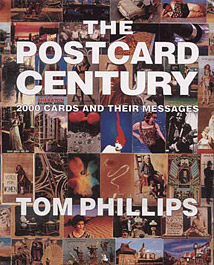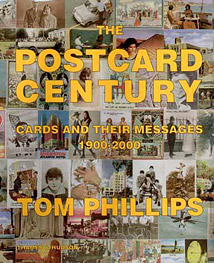The Postcard Century: Wish You Were Here by Simon Callow
This article first appeared in The Observer 1st October 2000
THERE IS A LATE twentieth-century school of contemporary artists of sometimes radically different aesthetics, working in widely varied disciplines - film, music, painting, sculpture, wire construction, stage design, furniture, literature, criticism - all of whom choose, perhaps whimsically, to call themselves Tom Phillips. At least that is one explanation of the phenomenon.
You can encounter his work in many different contexts: at lunch at the Ivy, for example, where you may have sat under his painted panel of artists who had other day jobs (Chekhov, Charles Ives, Eliot et al ), or have gazed through his glass screen in the same restaurant, or even toyed with his word cube at the back of the bar, spelling out gnomic, sometimes profound aphorisms.
You may have wandered into the Africa exhibition at the Royal Academy; he curated it. Perhaps you have a postcard of his painting of Samuel Beckett directing Waiting for Godot, superscribed with the immortal remark: No Matter. Try Again. Fail Again. Fail Better. Maybe you went to Otello at the ENO and saw his designs, and heard the singers singing his translation of the libretto.
Did you perhaps see his TV Dante, in which, with Peter Greenaway, he pushed the visual possibilities of the small screen beyond anything that had been attempted before or has much since? Or read his translation of The Inferno? Or his 'treated novel', A Humument, in which certain words in the Victorian text have been highlighted to create weird poetry, visual and verbal? Or perhaps you saw his opera, Irma? Or read the monthly column on music in painting for BBC Music Magazine
In every one of these media he has mastered a new language, then quietly created a revolution within it. This year's portrait of Susan Greenfield at the National Portrait Gallery is the first genuine twenty-first-century portrait, radical in its use of photographic and graphic technologies, a sequence of 26,000 images to create a complexity of depiction beyond the most exalted dreams of the cubists. It reinvents the genre, yet it may have passed unnoticed, since it came as part of no manifesto, was presented as no Sensation, but was one of a number of medical portraits by several hands.
Phillips mans no barricades; he is like a mole, in both zoological and le Carre senses. Following his nose, driven by his subtle curiosity, he digs deeper and deeper into whatever it is that has caught his fancy, with many a complex joke along the way, getting closer and closer to the heart of the matter - a spy in the house of art. Very often, the point of entry has seemed most unpromising. But Mole Phillips knows better. If you keep going, you end up at the centre of the world. So it is with The Postcard Century
It sounds like the idea of madman, a Pooterish activity taken to a pitch of absurd ambition, a life's work invented by some wickedly satirical novelist: to tell the history of the twentieth century through postcards. Postcards - the very word seems to belong to another epoch. They are things sent by maiden aunts from Bexhill to their sisters in Sydenham, surely? But Phillips would answer, quite fiercely, first, that maiden aunts and their sisters are deeply interesting, as everything is if examined properly and compassionately, and second, that everyone has at one time or another sent and received postcards.
It is (or was) a universal habit. Postcards were first approved by the Post Office as late as 1894, so they almost perfectly coincide with the twentieth century (Phillips doubts whether they will outlast it), providing a constantly changing pictorial record of fashion and taste. But beyond that, he says: 'It has defined life rather than mirrored it, giving a more human picture of the world than any other medium.'
The picture is only the half of it. Phillips is as concerned with what is written on the cards, 'these marvellous receptacles of memory, bearers of image and carriers of news'.
Examining the formulas adopted by most writers of cards - inquiries about health, weather report, comment on delights of place depicted what he calls the haiku of the medium - he uncovers whole worlds of experience in their brief and frequently ungrammatical phrases, a poetry which discloses the 'authentic inconsequentiality' of lived life. His interest in all human activity, probing, tender, precise, respectful, as if he were a surgeon of the human condition, lends this book a deeply touching dimension.
The story of Max Church, for example, author of a series of postcards during and after the Second World War, culminates in what Phillips rightly calls 'a message that could be expanded into a novel': 'Dear Dad. When you write next time could you include Pierre Braun's name, it will make him feel that my parents have accepted him as he has accepted me.'
The author's labyrinthine mind, encompassing history, sociology, psychology and the further reaches of philosophy, finds its perfect expression in the annotations attached to each card - 20 or so per year - quietly (that word again) delivering a detailed meditation on twentieth-century life. It is, he says, his millennium project and it is worth a thousand Domes.
It is a monument, of sorts, an intimate portrait both of the last century, but also of Phillips himself. His affection for mankind in all its quirkiness extends to the collectors of cards themselves, the deltiologists, if they're American, or, if they're French, les cartophiles. The Goat Man (they are identified like Freudian case histories) has discovered a hidden caprine world in which the supposed main event of the postcard is, for him, subservient to the glimpse of goat it obscurely contains; inevitably, Phillips notes, he sports a little grey beard.
One signs himself Old Mr Postcard, which is almost what Phillips has become. His obsessive odyssey now at an end, a tinge of melancholy pervades the pages of what is a perfect and a perfectly original book, splendidly produced by Thames and Hudson, whose name is celebrated with the inclusion of an annual postcard depicting, side by side, Piccadilly Circus and the Manhattan skyline.
It has the appearance of a coffee-table book, but beware - open it at any page and you will be there for the duration.
Copyright © 2000 Simon Callow. All rights reserved.
See The Postcard Century in the Trade Publications section.


